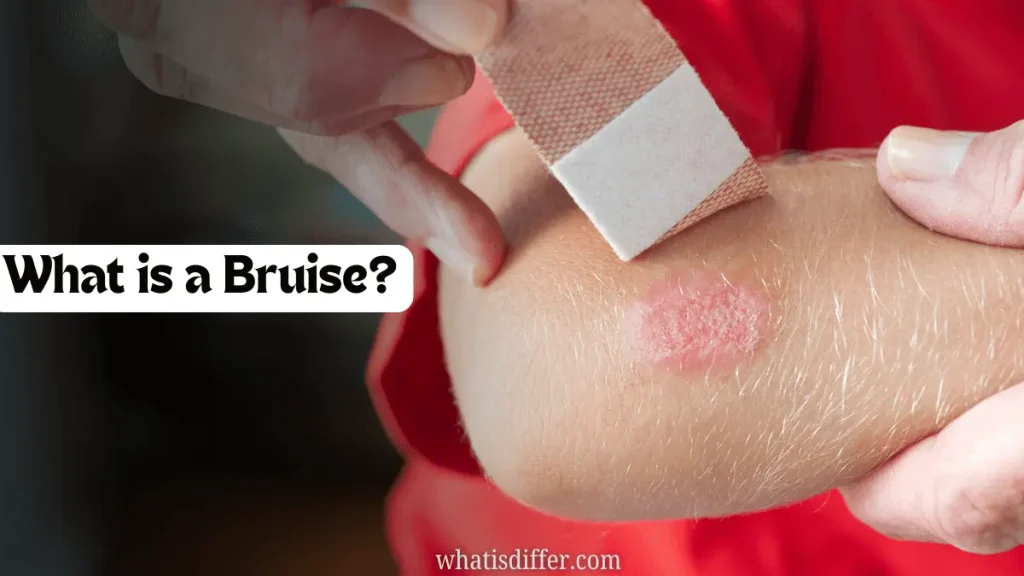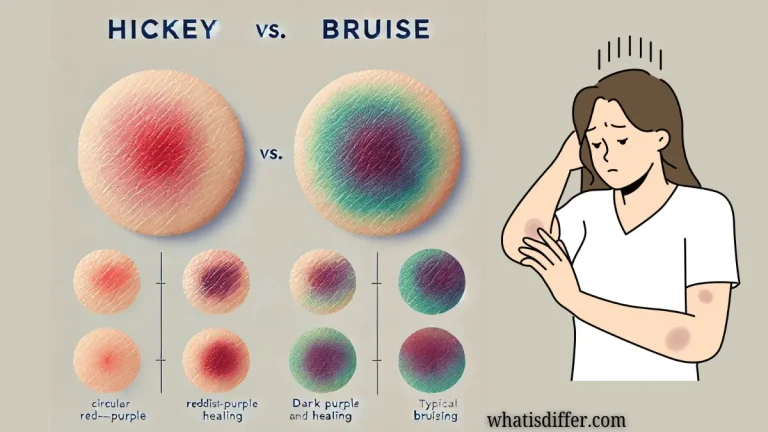Hickies and bruises look similar to one another, which is the main reason why people cannot distinguish between them. A dark red or purple discoloration on the skin indicates them both.
Moreover, they both result from blood vessels breaking and bleeding under the skin. Blood vessels rupture and leak blood under the skin to cause hickeys and bruises, both hematomas.
The difference between hickey and bruise is that a bruise is a skin discoloration that is dark red or purple and is brought on by an injury. A hickey, on the other hand, is a dark red or purple mark on the skin brought on by strong suction.
Let us learn the basic difference between hickey and bruise below:
Table of Contents
What is a Hickey?
Hickeys are marks made on the skin when someone suctions on it with their mouth, and are often taken as expressions of love and passion.
Hickeys are essentially just bruising from damaged blood vessels brought on by sucking. Even a little bit of biting or intense kissing may cause a hickey.
While some may regard giving or receiving a hickey as a pleasant and amusing way to show someone you care about them, others may see it as a more severe or private gesture.
Additionally, given that it might leave a mark on the skin that might be challenging to cover up, some individuals may view giving or receiving a hickey as risky or even dangerous behavior.
.
When delivering or receiving a hickey, it’s crucial to consider possible outcomes and be aware of potential concerns.
What is a Bruise?

Blood that has leaked out of the vessel causes bruises. Blood in our bodies is closely regulated so that it doesn’t clot inside our blood vessels but does so when it is outside the channel. Homeostasis is the name of this process.
A bruise is an early skin injury that causes the skin to become discolored. Deep under the skin, blood from damaged blood cells gathers close to the skin’s surface, causing what we see as a “black and blue mark.”
Humans often sustain bruising when they strike something or when that thing strikes them.
Some persons who exercise vigorously, such as athletes and weightlifters, may get bruises. These bruises are the result of tiny blood vessels.
Difference Between Hickey and Bruise
The basic difference between hickey and bruise are below:
The main difference between hickey and bruise is that unexpected bruises can be of any shape and size. While hickeys are often an oval created by the mouth.
Another important difference between hickey and bruise is that most common bruises result from internal pressure (hitting a body part against a hard surface). On the other hand, a lot of suction is used to make hickeys.
Another comparison between hickey vs. bruise is that most individuals dislike receiving hickeys, whereas many (but not all) people perceive bruises to be painful.
Most ordinary bruises are accidental, while many (again, not all) hickeys are intentionally created.
Hickey Vs. Bruise
The simplest comparison between hickey vs. bruise is below:
They are both bruises and resemble one another closely. Hickey is created by sucking a white person’s neck or upper arms firmly. Running into something, getting struck by an object, or being punched can all result in bruises.
Bruises are typically found on the legs (especially on women), although if enough bodies are inspected, they can be found everywhere on the body.
Bruise Vs. Hickey : Causes
The main causes between bruise vs. hickey are below:
Causes of a Bruise
Under the skin, microscopic blood vessels known as capillaries break or burst, which results in bruises.
When small capillaries are damaged by blunt force trauma, bruises or contusions result. Blood leaks into the surrounding tissue as a result. A hematoma has developed. Accidents, falls, and other events are the most common causes of bruises.
Causes of a Hickey
The suction from your partner’s lips harms little blood vessels under your skin, called capillaries. Your capillaries start to leak blood due to this injury, but the blood has nowhere to go. This causes it to become stuck under your skin, developing a purple hue and a hickey.
Similarities between Hickey and Bruise
A “hickey” and a bruise almost appear as the same thing. Both are the result of damage that breaks capillaries directly beneath the surface.
Little blood that has already lost its oxygen is released when blood arteries burst. This blood is attached to red blood cells and tissues, giving it a bluish tinge rather than the red color of arterial blood that still contains oxygen.
Hickey Vs. Bruise: Healing Process
Healing Process of Bruise
To treat the bruises, use an ice pack. By decreasing the temperature of the blood vessels and surrounding tissue, applying ice to these regions will help fade bruise traces over time.
This will stop blood from flowing into the surrounding tissues in the future. Apply the ice pack to the bruises, wrap it in a towel, and let it sit for 10-15 minutes. Once the bruise marks disappear, perform this action each day, ideally in the morning.
Healing Process of Hickey
You can apply a hot compress to quicken the healing process. You might use a hot water bottle, or a clean towel dipped in warm water to the hickey. The hickey can also be massaged and removed with a hot pad or warm towel.
What is the Difference Between Hickey and Bruise?
Highlighting the main difference between hickey and bruise in the following table:
| Hickey | Bruise |
| Bruises can be of any size or shape. | Hickeys are mostly of oval size. |
| Biting or sucking on the skin can result in hickeys. | An injury that applies sudden, intense pressure to the skin, such as a fall, can result in bruising. |
| People are less concerned about covering up bruises. | People are completely conscious of hiding hickeys. |
| Hickeys are less painful. | People experience more pain when they have bruises. |
Conclusion
The difference between hickey and bruise is that a person’s neck or upper inner arms are used to make a hickey. On the other hand, a bruise might result from knocking into something or being hit by a hard object.
Frequently Asked Questions
1) How does a bruise seem so?
When fresh, oxygen-rich blood has collected beneath the skin, bruises usually start as a red mark on the skin. The spilled blood starts to lose oxygen and change color after one or two days. Your bruise may be different colors of blue, purple, or black, depending on its size and intensity.
2) How long do hickeys last?
Hickeys may stay for two days or two weeks. As your body assimilates the blood, it changes hue along the route. The size of the bruise could influence the length of time it takes for one to go away. A bigger hickey could require more time to go away than a smaller one.
3) Are hickeys a form of abuse?
(It differs) If there is consent, hockeys can be a joyful, risk-free method of expressing affection. If there isn’t permission, hickeys (and other markings) can be oppressive and abusive. It’s critical to respect limits, inquire about each partner’s comfort level, and have open conversations about it.
4) Can a bruise look like a hickey?
Yes, a bruise resembles a hickey due to the same discoloration, which makes it difficult for some people to differentiate between the two.
Read More: What is the Difference Between Ground Fault and Short Circuit?


